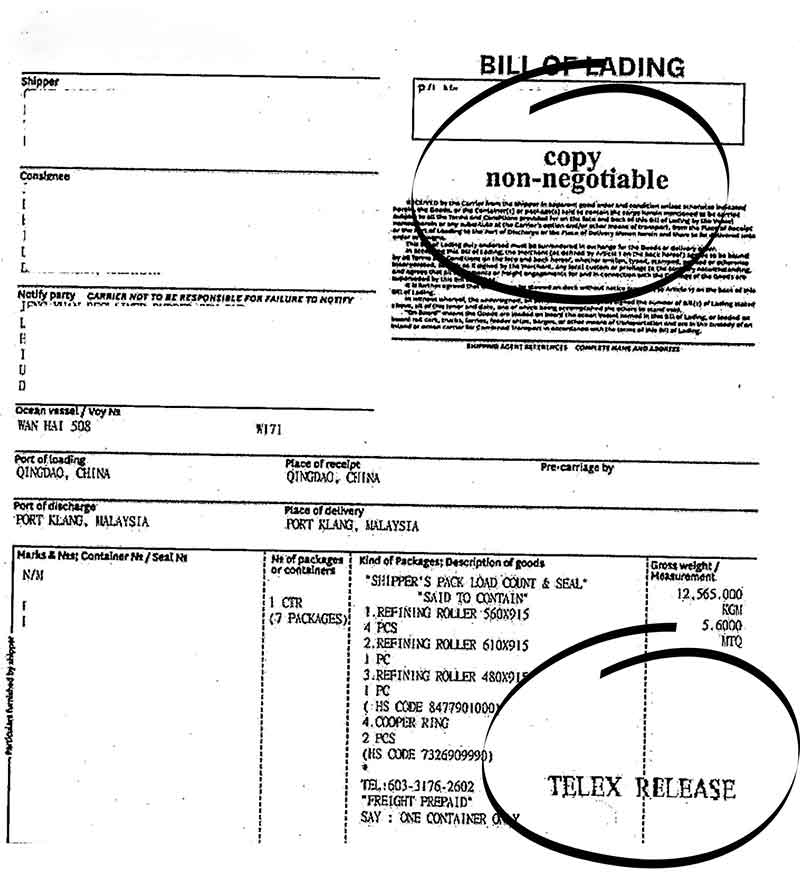Navigating international logistics can be tricky, especially when dealing with the many shipping documents. One term that often causes confusion is telex release. In this article, we’ll break down what a telex release is, how it functions, and what you need to be aware of when handling one.
What is a telex release?
When a Bill of Lading (B/L) is issued, there are only two ways to release the cargo:
- Via a telex release
- Through an endorsed Original Bill of Lading (OBL)
A telex release essentially involves an electronic message sent by an agent or shipping line from the port of loading (POL) to the port of discharge (POD).
For example, imagine a container being loaded in Shenzhen, China, while the shipper is in the UK. Their agent sends a release authorization to the destination port, allowing the consignee to collect the cargo without presenting the official OBL.
For a telex release to occur, certain conditions need to be fulfilled.
First, a physical, original Bill of Lading must have been issued, printed, and surrendered. Additionally, the surrendered Bill of Lading should have been a Straight B/L.
Below, you’ll find a simplified diagram illustrating this process.

To fully grasp the concept of a telex release, it’s crucial to understand the role of a Bill of Lading.
The Bill of Lading is a protection mechanism for the shipper. It functions as a proof of ownership, a contract of carriage, and a receipt for the shipment. B/Ls can be divided into two categories: negotiable and non-negotiable.
Typically, a Bill of Lading is non-negotiable by default, often referred to as a “Straight Bill of Lading,” as it represents a document of title (proof of ownership).
On the other hand, a negotiable Bill of Lading allows goods to be delivered to a “bearer” or a person “to order,” meaning the document can be transferred, giving ownership rights to someone else.
Regarding telex releases, they are mainly used when the Bill of Lading is a non-negotiable Straight Bill.
Example of a telex release

What about the Original Bill of Lading?
The original Bill of Lading (BOL) is a physical document provided to the shipper by the carrier at the loading port, either as a Straight Bill or an Order Bill. Generally, the consignee can only receive the cargo at the destination after presenting one or more original BOLs.
However, there are two scenarios where cargo can be released without presenting the original bill:
- The original BOL has been surrendered at the port of loading or elsewhere. The carrier can send a message to the destination port authorizing the release of the cargo without needing the original document.
- A Seaway Bill was issued. Since no original Seaway Bill exists, so there’s nothing to surrender at the port.
Why choose a telex release instead of the original B/L?
- The release is sent electronically, eliminating the risk of lost documents.
- It’s faster, avoiding delays when shipping the physical bill of lading (which could lead to detention or demurrage charges).
- It’s especially beneficial for short voyages, where there isn’t enough time to send the documents by courier.
However, the main drawback of a telex release is the risk of email fraud, which is beyond the consignee’s control. Fraudulent emails can lead to the improper release of cargo. That’s why you should work with Airsupply who has strong cybersecurity measures and protocols to prevent such risks.
How about telex vs express release?
You might have heard the term “express release” as well. This document can be in electronic or paper form. However, the telex release and express release are not the same.
Before choosing between a telex or express release, you should confirm whether an OBL has been issued, printed, and endorsed. If it has, an express release is not an option. Express releases are only applicable when there is no Origin Bill of Loading.
Why wouldn’t there be an OBL? It usually happens when the receiver is a trusted business partner or when there is a strong, established relationship between the shipper and consignee. In these cases, there’s no need for an OBL to secure payment.
Keep in mind that express releases can have different names. One example is the Seaway Bill, which is a type of express release, not an OBL.
Conclusion
At ASLG, we understand the complexities of international shipping. Whether you need guidance on handling Original Bills of Lading or require assistance with electronic releases, ASLG has you covered.
Our team of experts ensures smooth communication between shippers, consignees, and carriers, helping you avoid delays and reduce costs. Additionally, with our comprehensive global network, we provide customized, efficient logistics solutions tailored to your needs.
FAQs:
Who issues telex releases?
This document is typically issued by the carrier handling the cargo. In cases where a Non-Vessel Operating Common Carrier (NVOCC) is involved, they may also facilitate the process by coordinating with the shipping line to issue the telex release.
How do you send a telex release?
Historically, telex releases were sent through telegraph machines, which is how the name “Telex” originated. Today, however, most shipping lines offer the convenience of requesting a telex release through their online platforms, making it much easier and faster to obtain.
Is Sea Waybill the same as telex release?
No. A Sea Waybill is a non-negotiable document that acts as both a contract of carriage and a receipt for the goods, but it does not need to be physically presented to release the cargo. The consignee can claim the goods without an original document.
In summary, a Sea Waybill does not involve the creation of an original Bill of Lading.




